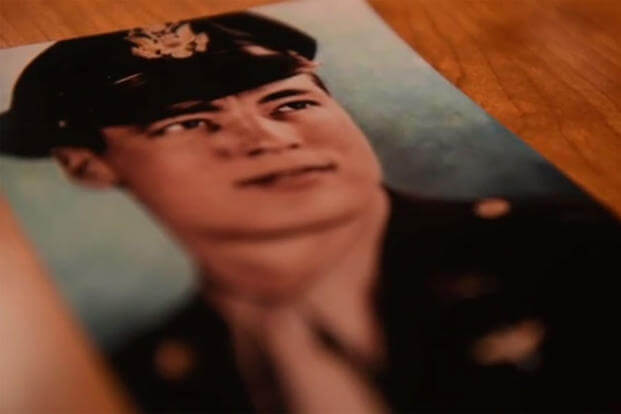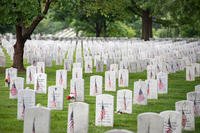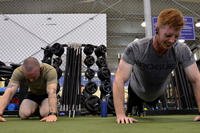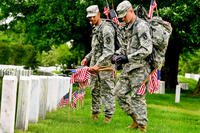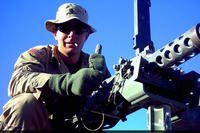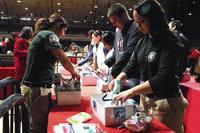By all accounts, Jimmie Collins and Welborn Smith were all-American boys who left their small hometowns to defeat Hitler and Nazi Germany.
Collins was valedictorian, a star athlete and popular at Lowndes County High School in Fort Deposit, Ala. He realized his dream of becoming an Army pilot and flying missions in the European theater.
Smith, who grew up in Roberta, Ga., was the third of five boys and so well-liked that everyone understood he was “mother’s favorite.” He followed his two older brothers into the service, choosing the Army Air Forces.
Their paths crossed when they were assigned to the 446th Bombardment Group, 20th Combat Wing, 2nd Bomb Division. Second Lt. Collins was the co-pilot, while Staff Sgt. Smith served as the engineer and gunner of their B-24 Liberator, Connie.
In the last known photo of the two men, Smith is standing behind Collins, along with eight other crew members in front of the plane. It is perhaps fitting that Smith is looking over Collins, as their fates and families became linked decades after the Germans shot down Connie over the Netherlands on June 21, 1944.
MOURNING JIMMIE
It’s unclear why Connie turned around only 25 miles from safety at the Bungay airfield in England after completing a bombing run over German-occupied land. Instead, it flew straight toward the enemy. Even though it had its landing gear down, signaling a surrender, Connie sustained a direct hit, sending the plane into a farmer's field near Amsterdam.
Collins was likely killed instantly. Smith grabbed a parachute, which did not open; he died when he hit the ground. The only survivor was Sgt. Peter Bausano of Michigan, who was forced by the Germans to carry Smith's heavy parachute for days as punishment.
Smith’s body was transferred from a cemetery in Hoofddorp, Netherlands, to the family burial plot in Roberta in 1946.
Similar closure would not come for the Collins family for more than 70 years.
RELATED VIDEO:
Tucked away in the Rio Grande National Forest is Soldierstone, a memorial honoring the nations and peoples who helped the U.S. during the Vietnam War.
The loss of her only child devastated Mary Duke Collins Silverman. Even though she baked and cared for extended family and friends, she mourned Jimmie every day until she passed away in the 1980s. After his disappearance, Silverman moved to a small house on Broadway, the main road in Sylacauga, Ala.
“Every time Aunt Mary would see a man in uniform come up the sidewalk she would run out and look and hope that it was Jimmie,” says Mary Brooks, his cousin. “She was always hoping that he would come home and, of course, we did too.”
Silverman would never embrace her son again or see to it he had a proper burial. But family members keep his memory alive.
“We were very proud of Jimmie for serving our country,” Brooks says. “We were thankful to be a family member of his and very sad that he didn’t return.”
ONE LUCKY CLUE
The telegram announcing news of Welborn Smith’s death stunned the gunner’s family.
“My mother never got over losing that boy,” recalls Bob Lee Smith, Welborn’s brother. “Her entire personality changed. She was not quite as jovial as she was. You could just tell there was always a dark cloud. My dad was the same way, but he hid it better. The first time I ever heard my dad cry was the day we got that message.
I never saw him cry again.”
Nearly a half-century later, fate would again bring the Smith and Collins families together.
In 1992, Bob Lee Smith — who was 8 when his 20-year-old brother was killed — went on a business trip to Holland with his wife, Tee.
Thanks to a bit of luck during that visit, a lot of perseverance and modern DNA technology, Jimmie would eventually come home.
Smith knew his brother’s plane had crashed near Amsterdam but had little else to go on, other than an eyewitness account by Jacob Wolfert. In 1944, Wolfert wrote a letter to the War Department, detailing how the Germans had shot down Connie and his participation in giving seven U.S. soldiers a proper burial.
A noncommissioned German officer “made the remark that the coffins were too much of a luxury for the pigs, as were the mourning feathers on the horses’ heads and the mourning clothes,” wrote Wolfert, who was a member of the Dutch resistance. “He thought this was scandalous and would report it.”
Based on information in the letter, Smith hoped to find Nieuw-Vennep, a town of 30,000 people in the Dutch province of North Holland.
Upon arrival at the Amsterdam airport, Smith asked a woman at the information center if she knew where Nieuw-Vennep was located. Not only did she live there, but she confirmed that Wolfert was alive and called the 89-year-old to set up a meeting.
“Everything fell into place like you would not believe,” Smith recalls. “We had no idea how anything would really go, but it was incredible. Mr. Wolfert is a hero. When we got there the next day, he said he was just about to discard all those old papers, mementos and everything he had. He said he didn’t think anybody would ever come, show up or ask about it.”
Instead, Wolfert passed along his research, retold the story of the crash and showed the Smiths where Connie’s crew members were initially buried. On Dec. 18, 1945, the graves had been reinterred at the Netherlands American Cemetery at Margraten in south Holland.
“As we stood there in the rain, I thought of my deceased parents and how they would have been comforted to know that Wolfert and other strangers like him had tended so lovingly to their son’s remains,” Smith says.
Wolfert told Smith that amid the wreckage he found a Bible belonging to crew member John Nicholson, along with a note from Welborn to his mother, Nora Smith.
“Seeing Welborn’s name and serial number, as well as my mother’s name, on Mr. Wolfert’s report was a wrenching experience for me,” he says. “Here I was, thousands of miles and an ocean away from Georgia, yet I had never felt closer to my family than at this moment.”
Later that day, while touring the crash site, Smith vowed to confirm the whereabouts of the missing crew members.
“When we were there, the thing that worried me was the fact that these guys’ bodies had not been recovered to either go into the cemetery in Holland or come home,” he says. “That started my quest to try to excavate the site and find Jimmie Collins, and that’s what started the whole thing.”
Smith deduced that seven crew members, including his brother, had been buried; there was one survivor, leaving two still unaccounted for. Sgt. Edward McHugh is still classified as missing in action.
He worked with the media to put pressure on the Dutch government, finally persuading it to excavate the crash site in 1997 before a planned airport expansion.
“That’s where Jimmie Collins’ remains were found,” he says.
In the spring of 2015, DNA tests confirmed the pilot’s remains.
“He gave his life for the country, which includes me and my family,” Smith says. “We would not be here today if it were not for those men. I think anybody with any compassion would feel that way, but I was driven to do it just simply by being a fellow American, and having a brother who was a fellow crew member who gave his life. What I did was nothing.”
JIMMIE’S LEGACY
The identification and repatriation of Collins’ remains, as well as his burial, have ignited interest in his story beyond the adults in the two families.
Sam, the 6-year-old grandson of Mary and Bruce Brooks, is fascinated by the story. He often asks about “visiting Jimmie” — accompanying his grandparents to the gravesite and helping tidy up the burial plot in Sylacauga.
“Sam has just become so involved with this story and with Jimmie,” Bruce says. “Every now and then he will pop up with a question: ‘How did Jimmie die? What kind of plane did Jimmie fly?’ We’ve bought a model airplane of a B-24 Liberator and are going to put it together. He’s looking forward to doing that.”
For Bruce and Mary, educating grandsons Sam, Brooks and Sawyer is about more than honoring Jimmie’s memory.
“I’m beginning to understand a little bit more about the sacrifice that not only they make — those who served from when we won our independence from England all the way up until now — but the sacrifice their families make,” Bruce says. “To see what Mary experienced and to know that through the ages we have had families that also have experienced that.
“I am so thankful because we have a good life here, and part of that good life is because people have been willing to sacrifice and to serve.”
A PROPER GOODBYE
On June 29, 2015 — 71 years and eight days after Connie was shot down — Jimmie Collins was laid to rest with full military honors. American Legion Post 45 of Sylacauga performed honor guard duties.
“Aunt Mary would be very happy that he had been found,” Mary Brooks says. “She was very proud of him because he wanted to serve his country and sacrificed his life for us.”
The Collins family invited Bob Lee Smith to the funeral. Taps was sounded, memories were shared, and thanks were given on a day that the Collins family doubted would ever come. Jimmie was buried next to his mother.
At the close of the funeral, Smith paused at the flag-draped casket, gazed down and whispered to Collins, “You’re home.”
